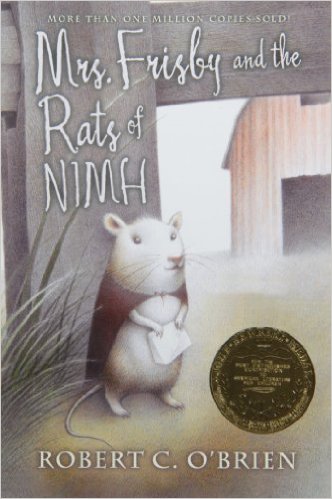[button color=”black” size=”big” link=”http://affiliates.abebooks.com/c/99844/77798/2029?u=http%3A%2F%2Fwww.abebooks.com%2Fservlet%2FSearchResults%3Fisbn%3D9780689710681″ target=”blank” ]Purchase here[/button]
This book was the basis for the MGM/UA animated movie The Secret of NIMH. It (the book, not the movie) won the Newbery Medal in 1972. The main character is Mrs. Frisby, a widowed field mouse who, with her two sons and two daughters, lives under a tree in a meadow in the summer, and inside a cinder block in a farmer’s field in the winter. As the story opens, the time for moving out of their winter house approaches (when the frost breaks up, the farmer will plow his field, so their home will be destroyed). But Mrs. Frisby has a problem. Her younger son, Timothy, a frail but very intelligent and kind little mouse, comes down with pneumonia and while he is recovering (thanks to medicines made by an old white mouse named Mr. Ages) he cannot be moved. He has to stay in bed, and he can’t survive even a breath of cold or damp air, the likes of which he is sure to run into if they move to their summer house now. Mrs. Frisby is desperate to figure out a solution to her dilemma: for as it stands, they can either move, and Timothy will die; or they can stay put, and all die together.
Thanks in part to a favor she does for a young crow named Jeremy, and in part to the memory of her late husband who had connections she didn’t even dream of, and again in part to the advice of an owl, Mrs. Frisbee turns to a neighboring colony of rats for help. The rats have always kept to themselves, but she soon finds out that these are no ordinary rats. They are super-intelligent rats, escaped from a laboratory, able to read and write and to use machines and electrical appliances.
Mrs. Frisby learns that her husband and Mr. Ages escaped from the same laboratory, and that they are planning to move away from the farm (where they have lived by stealing everything from food to electricity) to an isolated valley where they can begin an advanced rat society in which they will raise their own food and build their own civilization. They help her and she helps them in a dramatic and suspenseful adventure which, toward the end, is tinged with a bit of sadness and just enough uncertainty as to how certain things turned out, that you almost wish a sequel had been written (if you know of one, let me know!).
I thank all of you who wrote to me to tell me about Racso and the Rats of NIMH and R-T, Margaret, and the Rats of NIMH, which were written by a different author named Jane Leslie Conly.

